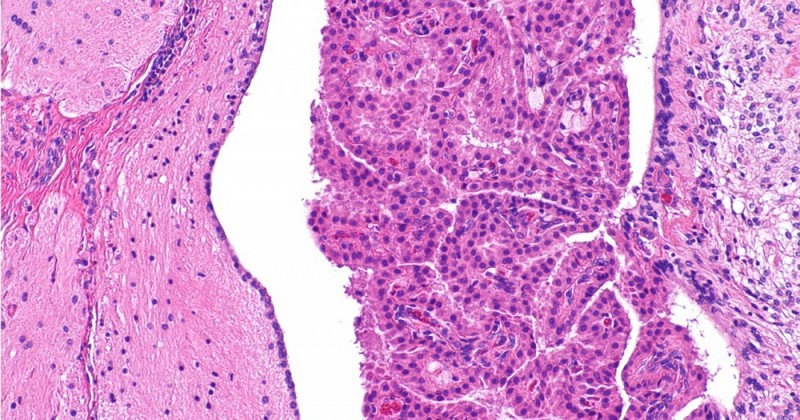Choroid plexus: anatomy, functions and pathology

The human brain is filled with ventricles through which a protective fluid circulates.
Cerebrospinal fluid is essential for the functioning and hygiene of the central nervous system, especially the brain. This substance is produced in the four structures known as "choroid plexuses", located in the cerebral ventricles.
In this article we will describe the anatomy and main functions of the choroid plexuses.. We will also mention the pathologies most frequently associated with these regions of the central nervous system.
Anatomy of the choroid plexuses.
The choroid plexuses are located in the ventricular system of the brain; there is one plexus in each of the four ventricles. Its nucleus is formed by connective tissue, capillaries and lymphoid cells, and is surrounded by a layer of epithelial cells. The epithelium is responsible for the production of cerebrospinal fluid, the main function of the choroid plexus.the main function of the choroid plexus.
In addition, this structure separates and connects the central nervous system and the circulatory system, which explains the involvement of the choroid plexuses in the transport of nutrients and hormones to the brain and in the elimination of residual substances.
The ventricles are four interconnected brain cavities. After being generated in the choroid plexuses, which are found in virtually all regions of the ventricular system, cerebrospinal fluid circulates through the brain via the ventricles until it reaches the spinal cord. to reach the spinal cord.
Functions of this structure
The number of functions attributed to the choroid plexuses has increased in recent years; they have been found to be relevant not only for their ability to manufacture cerebrospinal fluid and protect neurons, but also to fulfill additional roles that could lead to therapeutic benefits as research progresses in the future.
1. Cerebrospinal fluid production
Cerebrospinal fluid serves several key functions in the central nervous system: It cushions the brain from shocks and allows it to maintain its density. and allows it to maintain its density, participates in immune defenses, regulates homeostasis (extracellular balance) and helps to eliminate waste substances from the brain.
2. Blood-brain barrier formation
The epithelial tissue of the choroid plexus makes up part of the blood-brain barrier, which separates Blood and fluid from the brain. separates blood and extracellular fluid from the central nervous system. but allows the exchange of nutrients and wastes. It also has a defensive function by preventing the entry of certain toxins.
3. Maintenance of extracellular homeostasis
The extracellular balance of the brain and spinal cord is maintained in part by the choroid plexuses, which modulate the interaction between the central nervous system and the immune system.
4. Regeneration of tissues and neurons
Choroid plexuses secrete neuroprotective compounds that promote the healing of neuronal damage; this effect has been related especially to traumatic injuries. In addition, a certain degree of neuroprotective a certain degree of neurogenesis (production of new neurons from (production of new neurons from progenitor cells) even in adulthood.
5. Detoxification of the brain
The choroid plexuses contribute to brain detoxification in two ways: on the one hand, the cerebrospinal fluid they produce fulfills this function, and on the other hand, their connection with the circulatory system facilitates the transfer of residual substances to the blood to allow their elimination.
6. Other functions
In addition to the processes we have described, in recent years research has begun to investigate the role of the choroid plexuses in other functions: the production of polypeptides that nourish the neurons, the transfer of information to the sympathetic nervous system...
Pathologies of the choroid plexuses
Since the choroid plexuses, and in particular the cerebrospinal fluid they produce, perform fundamental functions for the organism, alterations in the anatomy and functionality of these structures can favor the appearance of various pathologies.
There are also a large number of factors that occasionally cause alterations in the choroid plexuses. The relationship of these structures with Alzheimer's disease, stroke and craniocerebral trauma is particularly relevant.The relationship between these structures and Alzheimer's disease, stroke and traumatic brain injury is particularly relevant.
In people with Alzheimer's disease there is atrophy in the ependymal cells of the choroid plexuses; this causes a decrease in the production of cerebrospinal fluid, an increase in oxidative stress and a greater accumulation of toxins in the brain.
On the other hand, and although it often does not have serious consequences, the appearance of cysts in the plexus, which cysts in the choroid plexus during fetal development can cause tumors and have been associated can cause tumors and has been associated with aneuploidy (alterations in the number of chromosomes in cells) such as Edwards' syndrome, which is fatal for most babies.
(Updated at Apr 12 / 2024)